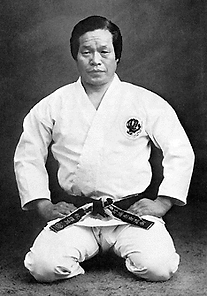
HAYASHI-HA SHITORYUKAI KARATE DO


Tokyo



Soke
Hanshi Hayashi Teruo (10th Dan)
Hayashi Teruo Soke Hanshi 10th Dan Okinawa Kobudo Kenshin-Ryu. J.K.F. Official Master Hanshi 9th Dan.
The President and Soke of Nippon Karate-do Hayashi-Ha Shito-Ryu-Kai. Advisor of Central Technical Committee Japan Karate-do Federation. Chairman Of Kinki Region Council Japan Karate-do Federation.
Hayashi was technical chairman of the World Union of Karate-do Organizations (W.U.K.O.) for more than 10 years, later reorganized as the World Karate Federation (W.K.F.), is the emeritus chairman of the referee council of W.K.F., and in 1995 received his 9th degree black belt from the Japan Karate Federation (J.K.F). President of the Osaka Prefectual Karate-do Federation. President of the Higashi Osaka City Karate-do Association. Director of the F.A.J.K.O., one of the highest judges of the F.A.J.K.O. He is without doubt one of the foremost karate masters in the world today.
Soke Teruo Hayashi is one of the greatest and most famous masters of modern Karate.
He is the founder, active headmaster and president of Hayashi-Ha Shito-Ryu Kai School of Karate-do and Japan Kobudo Kenshin-Ryu-Kai, and has its headquarters in Osaka, Japan. Hayashi was born in Nara, the old capital of Japan in the island of Honshu, in 1924. At age 14 began his martial arts training in judo having earned the rank of San Dan. At the age of 24 and after the war, he discovered Gojuryu karate and studied under Seiko Higa from 1949 to 1951 (Seiko Higa was a disciple of Chojun Miyagi and Kangyo Higaonna).
He has throughout his adult life displayed a fervor for learning karate perhaps matched only by one of his teachers, Kenwa Mabuni. His style is the result of over fifty years of research into and refining of the numerous Okinawan and Japanese Karate styles Hayashi Soke has studied over his amazing lifetime. Starting in Osaka, Japan, the birthplace of Shito-Ryu, Hayashi Soke studied under Kosei Kuniba, a chief disciple of Shito-Ryus founder, Kenwa Mabuni. Hayashi Soke did study briefly with Mabuni, but his daily instruction came from Kuniba, at least at first. It was not long, however, before the young Hayashi outgrew the experience Osaka had to offer.
Certainly, there were many kata to learn, and technique can never be perfected, but what the young Hayashi wanted most was new challenges, new faces to kumite with. Also, he knew Karates history. Karate came from Okinawa. His teacher came from Okinawa. His teachers teacher came from Okinawa. He must go to Okinawa! So it was that Hayashi Teruo, a young man with much ambition, set out to master the world, his opponents, and himself.
Hayashi took what may seem to Westerners as an insane approach to choosing the Dojo at which to study. He would walk into the Dojo and challenge the Sensei to a fight.
This, of course, incensed any students present at the time and they would insist on a chance to teach the chap a lesson themselves before their beloved Sensei would reduce himself to accepting a challenge from an upstart. This practice, some might say brave, others foolish, is actually a time honored tradition in Japanese and Okinawan cultures. It is known as Dojo Yaburi (challenge). While not practiced frequently these days, it was actually a common protocol when Hayashi was a young man. The way it worked was simple. The man that issued the challenge must first fight the lowest ranking man at the Dojo. If the challenger defeats the man then he is granted the right to fight the next lowest ranking man, and so on until the challenger is defeated or has himself defeated the Dojos Senpai (number one student). Then and only then is he allowed to challenge the Sensei himself, but is usually given the right to choose time and place as a reward for his previous efforts.
Hayashi became infamous for this practice, and resulting in being, very good at kumite. So much so that many Dojo refused his challenges outright and would not let them inside their doors. There were, of course, those that accepted. If Hayashi was beaten at one of these schools he would stay and ask for training. After all, what did he have to learn from those he himself had beaten! It was in this way that Hayashi sought not only knowledge, but respect from the Okinawans.
As a result of his tenacity Hayashi was able to garner much experience while on Okinawa. His primary teachers while on Okinawa were Nagamine Shoshin and Nakaima Kenko. From Nagamine Sensei he learned both the Shuri and Tomari lineages of kata. These kata tend to emphasize long linear stances and quick motion between stances. It was from this man that Hayashi learned the white crane form, Hakkaku.
From Nakaima Sensei, Hayashi learned a obscure family art called Ryuei-Ryu. This style is a southern tiger style imported from China four generations prior to Hayashis arrival on Okinawa. After a year of proving himself to the revered Nakaima, Hayashi was the first non-family member allowed to study the style. Hayashi incorporates much of Ryuei-Ryus theory into his own system.
Upon returning to Japan, Hayashi continued his study with Kuniba Kosei. From Kuniba, Hayashi learned the bulk of the Shito-Ryu syllabus, and as such it was the Shito-Ryu versions of the Naha kata that Hayashi was taught and still teaches. Hayashi was Kunibas number one student, and it was on his deathbed that Kuniba asked Hayashi to run his organization until his young son, Shogo, reached a level of maturity to assume leadership of the organization. Honoring his Senseis wishes, Hayashi became President of the Seishin-Kai until 1970 at which time Hayashi handed the mantle of leadership to the styles rightful heir, Kuniba Shogo, and founded his own style called Hayashi-Ha Shito-Ryu.